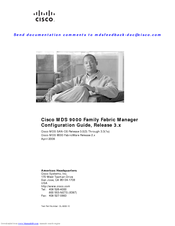HP Cisco MDS 9124 - Fabric Switch Manuals
Manuals and User Guides for HP Cisco MDS 9124 - Fabric Switch. We have 1 HP Cisco MDS 9124 - Fabric Switch manual available for free PDF download: Configuration Manual
HP Cisco MDS 9124 - Fabric Switch Configuration Manual (1384 pages)
Cisco MDS 9000 Family Fabric Manager Configuration Guide, Release 3.x (OL-8222-10, April 2008)
Table of Contents
-
-
-
-
Device Manager
107 -
-
-
-
-
-
Menu Bar153
-
Toolbar154
-
-
Filtering156
-
-
Information Pane156
-
Fabric Pane158
-
Context Menus160
-
Status Bar164
-
-
-
-
Toolbar Icons172
-
Menu Bar172
-
Dialog Boxes173
-
Tabs173
-
Legend174
-
-
Context Menus175
-
-
-
Performance
188 -
-
Licensing Model244
-
-
-
Configuring NTP274
-
-
-
Configuring CDP280
-
About CFS283
-
-
-
-
CFS Features284
-
CFS Protocol285
-
CFS Regions294
-
Default Settings301
-
-
-
Default Settings328
-
-
-
-
Default Settings356
-
About Modules357
-
-
Services Modules359
-
Default Settings368
-
-
-
Reason Codes380
-
-
Autosensing385
-
-
-
About Speed Leds386
-
-
-
About TL Ports390
-
Buffer Credits392
-
VSAN Interfaces396
-
-
-
About NPV399
-
Configuring NPV403
-
-
-
-
Buffer Pools428
-
-
-
Port Indexes436
-
Portchannels437
-
-
-
Default Settings451
-
-
-
Default Settings472
-
About Trunking475
-
-
-
-
Domain Ids490
-
About Domain Ids490
-
-
Default Settings504
-
About Vsans509
-
Vsans Topologies509
-
-
-
VSAN Advantages511
-
-
-
Default Settings520
-
About SDV521
-
-
-
-
Default Settings544
-
-
-
-
About Afids556
-
-
About IVR Zones566
-
Default Settings578
-
-
About Zoning579
-
-
-
Zoning Example580
-
Zone Sets593
-
Zone Enforcement603
-
-
Enhanced Zoning618
-
Default Settings623
-
-
-
-
About FSPF634
-
FSPF Examples634
-
-
FSPF Routes644
-
-
-
-
Flogi657
-
Fdmi660
-
Displaying FDMI660
-
Rscn661
-
-
-
FICON Cascading677
-
-
Port Addresses681
-
FC ID Allocation684
-
-
-
Port Prohibiting696
-
Port Swapping701
-
Swapping Ports703
-
-
World Wide Names717
-
-
About Roles734
-
Modifying Rules737
-
User Accounts742
-
About Users743
-
-
-
-
Deleting a User746
-
SSH Services746
-
Default Settings755
-
-
-
SNMP Version 3758
-
-
Switch AAA770
-
-
-
About TACACS+782
-
-
-
-
-
Port Information803
-
ICMP Information804
-
TOS Information804
-
-
-
OCSP Support817
-
-
-
-
Importingthe CRL848
-
-
Maximum Limits848
-
Default Settings849
-
-
-
About Ipsec852
-
About IKE853
-
Using Ipsec854
-
Crypto Ipv4-Acls871
-
-
Default Settings889
-
-
Dhchap892
-
-
-
Default Settings900
-
-
-
Auto-Learning914
-
-
-
Default Settings935
-
About FCIP939
-
-
-
FCIP Concepts940
-
FCIP Links941
-
FCIP Profiles942
-
FCIP Interfaces942
-
-
Fspf943
-
Vrrp944
-
-
Configuring FCIP
945-
Enabling FCIP946
-
-
Default Settings976
-
-
Data Pattern982
-
-
-
-
Enabling Iscsi990
-
Iscsi Access Control1010
-
-
Iscsi Listener Port1018
-
Iscsi Routing Modes1019
-
Configuring Islb1021
-
-
-
-
-
Locking the Fabric1034
-
CFS Merge Process1035
-
-
Isns1053
-
Example Scenario1056
-
Target Discovery1058
-
Isns Cloud Discovery1059
-
-
-
Default Gateway1065
-
Ipfc1067
-
Ipv4 Static Routes1067
-
Overlay Vsans1068
-
About Overlay Vsans1068
-
-
-
About VRRP1071
-
Configuring VRRP1072
-
Priority Preemption1073
-
-
Default Settings1075
-
Services Modules1077
-
-
IPS Module Upgrade1079
-
Supported Hardware1079
-
Vlans1082
-
Ipv4-Acls1083
-
Configuring CDP1086
-
Default Settings1086
-
-
About Ipv61095
-
Ipv6 Address Formats1096
-
-
Global Addresses1097
-
Link-Local Address1098
-
-
ICMP for Ipv61100
-
Router Discovery1103
-
-
Default Settings1109
-
-
SCSI Flow Services1113
-
-
-
SCSI Flow Statistics1118
-
-
Configuring Santap1127
-
Enabling Santap1127
-
Default Settings1131
-
Configuring Nasb1133
-
-
-
Configuring NASB
1138-
Default Settings1139
-
-
Device Discovery1143
-
-
-
-
Inventory Management1145
-
-
-
About RMON1159
-
-
About SPAN1170
-
SPAN Sources1170
-
SPAN Sessions1173
-
Specifying Filters1173
-
Configuring SPAN1174
-
Editing SPAN Sources1176
-
-
-
-
Module Logging1187
-
Log Files1188
-
Default Settings1193
-
-
Call Home Features1196
-
Cisco Autonotify1196
-
Contact Information1197
-
Destination Profiles1199
-
Alert Groups1200
-
Syslog-Based Alerts1203
-
RMON-Based Alerts1204
-
E-Mail Options1205
-
Event Triggers1214
-
Message Contents1217
-
-
Traffic Management
1231 -
-
About FCC1233
-
FCC Process1234
-
Enabling FCC1234
-
About Data Traffic1236
-
Creating a Class Map1239
-
-
Default Settings1244
-
About Port Tracking1245
-
-
-
-
About Port Tracking1246
-
-
Troubleshooting
1251 -
-
Running CLI Commands1263
-
-
-
GUI-Based Client1271
-
-
Capture Filters1273
-
-
-
-
Installation Issues1281
-
Is Running?1284
-
Services Menu?1284
-
General1285
-
Windows Issues1288
-
UNIX Issues1289
-
Other1290
-
-
-
Core and Log Files1305
Advertisement
Advertisement
